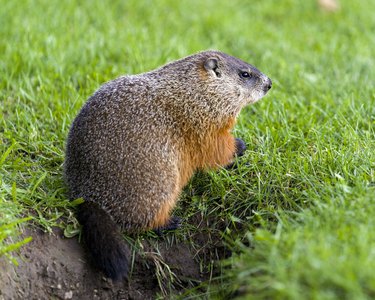
Out of sight, out of mind may be true in some scenarios, but it's not always the case when dealing with burrowing animals in your lawn. Getting rid of these ground dwellers often involves a variety of tactics depending on the type of animal responsible for the hole. In many cases, using scents they find offensive is enough to get them to leave. Removing or otherwise blocking things that are attracting them to your yard, such as their food sources, also helps.
Determining the Type of Animal
Video of the Day
Figure out which animal most likely made the hole to help determine the best way to get rid of it. For instance, a hole about an inch wide with no raised tunnels and with no mound of dirt near the opening could be for a chipmunk, as they usually hide their debris elsewhere. Chipmunk burrows are often in a semiprotected area, such as in a flower bed or close to your home's foundation.
Video of the Day
Moles and voles leave holes of around the same general size, but their digging priorities are a little different. Moles leave small conical mounds and have raised bumps of dirt along their pathways, which are shallow compared to a chipmunk's. A vole's tunnel path looks similar but without any dirt mounds.
Larger animals also burrow, such as gophers, pocket gophers, ground squirrels, prairie dogs, and groundhogs. Gopher species leave arced dirt piles near their sometimes-numerous tunnel openings. Groundhogs leave the largest holes of the group, and there's only one entrance to their burrow. If you aren't entirely sure which animal is responsible for a burrow in your yard, pay attention to which burrowing animals you see in the general area, as that's one of the greatest clues.
Stink Them Out
No one likes a stinky home, including burrowing animals, but what stinks to them isn't necessarily the same things humans find repulsive. Some burrowing animals dislike the smell of coffee grounds, so sprinkle some around the hole or holes and around any plants or areas the animals like. Crushed garlic cloves, garlic oil, and rosemary oil work in the same way. Any scent-based repellent must be reapplied when the scent fades, such as after it rains.
Predator urine or other animal waste or used kitty litter put near the opening of a burrow is an effective way to get an animal to stop using a particular hole for a tunnel with more than one opening. Spreading the same substances around your yard in key areas also keeps most burrowing animals away, as they all want to avoid predators.
Castor oil also repels various burrowing animals, so use it in areas where the animals are a problem. Place a little around animal holes while the animals are away or mix 1 to 2 tablespoons each of castor oil and liquid dish soap in a gallon of warm water. Then, spray it around areas you wish to protect.
Remove What They Seek
All burrowing animals need to eat, and some of them also prefer hiding out in areas of brush or other cover rather than spending a lot of time out in the open. Remove obvious food sources, such as fruit that has fallen from a tree. Protect garden plants by placing a chicken wire or hardware cloth fence around the garden with the fence buried a foot or so beneath the surface to prevent burrowing into the garden. The fence depth should be based on how far any particular animal might burrow.
If you have pets that eat food outdoors, bring the food in at night or switch to feeding them inside. Spilled birdseed is another attractant for animals, so switch to a feeder that has a catch tray beneath it or stop feeding the birds for a while. Animals such as chipmunks also enjoy hanging out in piles of wood or foraging in brush piles, so clean up such areas if you've noticed burrowing animal activity nearby.
Removing the Animals
In some cases, it's illegal to live trap and relocate animals, so check your local regulations if you're considering that option. For a serious infestation of rodents, such as moles, other traps, such as specialty mole traps, are also an option. Purchase the type of trap needed to catch that specific species; for instance, mouse traps probably won't be effective on moles.